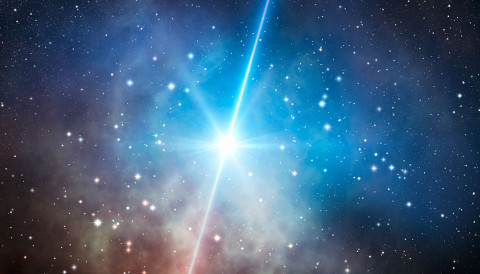An artist's conception of a gamma-ray burst. European Southern Observatory
Astronomers might be on the brink of developing a new rung on the cosmic distance ladder.
Astronomy is a discipline pursued at unimaginable distances. And yet actually measuring the distance to a nearby exoplanet, or to a galaxy shining at us from the dark depths of the cosmos, seems almost futile.
One of the simplest methods is to use standard candles — objects with a known intrinsic brightness — and infer their distances based on how bright they appear to be when seen from Earth.
Astronomers have used Type 1a supernovae (SNe) as standard candles to great success. These explosions are the death cry of a dense white dwarf once it has collected too much additional matter. But we’re constantly on the search for new standard candles that could be an independent rung on the cosmic distance ladder: a tool for measuring distances to farther and farther galaxies.
Now, two new papers submitted to separate journals have independently found that gamma-ray burst supernovae just might be “standardizable.” And although both have yet to go through the rigorous peer-review process, outside experts are commending their work as solid starting points.
Gamma-ray Bursts as Standard Candles?
Roughly once a day the sky is lit up by a mysterious flash of energy. These events — gamma-ray bursts (or GRBs for short) — are among the most explosive and energetic events in the universe, sending out as much energy in a fraction of a second as our Sun will give off during its entire lifespan. Long GRBs (lasting more than 2 seconds) come from massive stars going supernova.
“When these stars undergo core collapse, they form a ‘central engine,’ which is expected to either be a rapidly rotating black hole that is surrounded by an accretion disk, or a neutron star with an exceptionally large magnetic field,” says Zach Cano (University of Iceland), who authored one of the two studies. “When the core collapses, the central engine creates a bipolar jet that pierces through the star, and at a large distance from the star, creates a burst of gamma rays, and later an afterglow.”
Type 1a SNe are easily used as standard candles because the amount of light we receive over time follows a specific pattern. The plots of this emission, known as light curves, have a characteristic shape, allowing astronomers to determine the explosion’s intrinsic brightness based on this shape alone.
But at first glance, the supernovae that create GRBs have irregular light curves.
So Cano and a second, independent team comprising Xue Li and Jens Hjorth (both from University of Copenhagen, Denmark) simultaneously dug a little deeper. Both teams looked at separate sets of eight GRB-SNe events in order to search for any consistency across the light curves.

